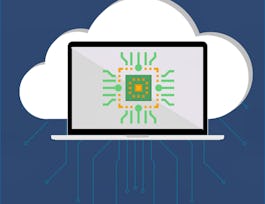Cloud computing systems today, whether open-source or used inside companies, are built using a common set of core techniques, algorithms, and design philosophies – all centered around distributed systems. Learn about such fundamental distributed computing "concepts" for cloud computing.



Cloud Computing Concepts: Part 2
This course is part of Cloud Computing Specialization

Instructor: Indranil Gupta
Sponsored by Barbados NTI
33,835 already enrolled
(318 reviews)
Skills you'll gain
- System Software
- Operating Systems
- Cloud Computing
- Cloud Infrastructure
- Security Controls
- Theoretical Computer Science
- Network Infrastructure
- Cloud Solutions
- Data Centers
- Infrastructure Architecture
- Computer Networking
- Data Storage
- Infrastructure Security
- Transaction Processing
- IT Infrastructure
- Computer Systems
- File Systems
- Distributed Computing
- System Programming
- Software Systems
Details to know

Add to your LinkedIn profile
1 quiz, 6 assignments
See how employees at top companies are mastering in-demand skills

Build your subject-matter expertise
- Learn new concepts from industry experts
- Gain a foundational understanding of a subject or tool
- Develop job-relevant skills with hands-on projects
- Earn a shareable career certificate


Earn a career certificate
Add this credential to your LinkedIn profile, resume, or CV
Share it on social media and in your performance review

There are 5 modules in this course
Lesson 1: To coordinate machines in a distributed system, this module first looks at classical algorithms for electing a leader, including the Ring algorithm and Bully algorithm. We also cover how Google’s Chubby and Apache Zookeeper solve leader election. Lesson 2: This module covers solutions to the problem of mutual exclusion, which is important for correctness in distributed systems with shared resources. We cover classical algorithms, including Ricart-Agrawala’s algorithm and Maekawa’s algorithm. We also cover Google’s Chubby support for mutual exclusion.
What's included
11 videos7 readings2 assignments2 discussion prompts1 plugin
Lesson 1: Transactions are an important component of many cloud systems today. This module presents building blocks to ensure transactions work as intended, from Remote Procedure Calls (RPCs), to serial equivalence for transactions, to optimistic and pessimistic approaches to concurrency control, to deadlock avoidance/prevention. Lesson 2: This module covers how replication – maintaining copies of the same data at different locations – is used to provide many nines of availability in distributed systems, as well as different techniques for replication and for ensuring transactions commit correctly in spite of replication.
What's included
8 videos2 readings1 quiz1 discussion prompt
Lesson 1: We study the emerging area of stream processing, touching on key design aspects of Apache Storm. Lesson 2: We study how enormous graphs can be processed in clouds. Lesson 3: We study various types of networks/graphs that are both natural and artificial, and their surprising commonalities. Lesson 4: This module presents classical scheduling algorithms that have been used in operating systems since the inception of computers. We then cover two popular scheduling algorithms for Hadoop.
What's included
9 videos2 readings1 assignment1 discussion prompt
Lesson 1: When files and directories are stored/accessed over the network, it is called a distributed file system. This module covers the working of distributed file systems like NFS and AFS. Lesson 2: This module covers Distributed Shared Memory systems, their techniques, and pros/cons. Lesson 3: This module looks at the area of sensor networks, starting from what’s inside a sensor mote and how networks of them work.
What's included
6 videos2 readings1 assignment1 discussion prompt
Lesson 1: This module is a primer on basic security concepts, not just applied to distributed systems, but also more generally. We study various policies and mechanisms, including encryption, authentication, and authorization. Lesson 2: This module presents case studies of real datacenter outages, and attempts to draw lessons on how to prevent them and how to better prepare for them.
What's included
11 videos3 readings2 assignments1 programming assignment3 discussion prompts1 plugin
Instructor

Offered by
Why people choose Coursera for their career




Learner reviews
318 reviews
- 5 stars
68.23%
- 4 stars
24.52%
- 3 stars
4.08%
- 2 stars
0.94%
- 1 star
2.20%
Showing 3 of 318
Reviewed on Feb 16, 2019
Would really help to get the correct answers for the questions one failed once the test is passed. The programming assignment could use additional tips and help
Reviewed on Dec 31, 2017
Very nice and informative course, and the programming assignment in the end of the course is so helpful to understand and apply the theoretical concepts that was introduced during the course
Reviewed on Mar 31, 2018
Awesome class for software engineers. If you haven't take it in college, or need a refresher, this is a great way to do so.
Recommended if you're interested in Computer Science

Duke University

University of Colorado Boulder

Amazon Web Services

Open new doors with Coursera Plus
Unlimited access to 10,000+ world-class courses, hands-on projects, and job-ready certificate programs - all included in your subscription
Advance your career with an online degree
Earn a degree from world-class universities - 100% online
Join over 3,400 global companies that choose Coursera for Business
Upskill your employees to excel in the digital economy



